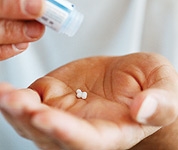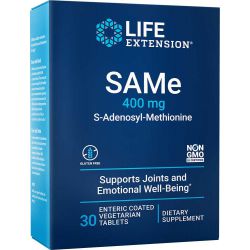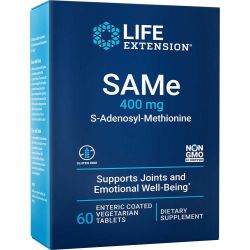Dépression. S-adénosylméthionine (SAMe) partie 1
%20part%201.jpg) En 2004, la FDA a demandé à tous les antidépresseurs de porter une mention «boîte noire» sur leurs étiquettes à la suite de la découverte d'un risque accru de pensées suicidaires chez les enfants prenant les pilules.1 En décembre 2006, à la suite d’une vaste analyse fédérale de centaines d’essais cliniques, les organismes de réglementation de la FDA ont reconnu pour la première fois que ces médicaments pouvaient déclencher des pensées suicidaires chez les patients de plus de 18 ans1.
En 2004, la FDA a demandé à tous les antidépresseurs de porter une mention «boîte noire» sur leurs étiquettes à la suite de la découverte d'un risque accru de pensées suicidaires chez les enfants prenant les pilules.1 En décembre 2006, à la suite d’une vaste analyse fédérale de centaines d’essais cliniques, les organismes de réglementation de la FDA ont reconnu pour la première fois que ces médicaments pouvaient déclencher des pensées suicidaires chez les patients de plus de 18 ans1. En fait, des scientifiques ont découvert que la SAMe avait bon nombre des mêmes effets bénéfiques sur l'organisme que les médicaments prescrits pour de nombreux troubles de la santé3-5. SAMe a non seulement 30 ans d’efficacité dans le traitement de la dépression 6, mais des preuves de plus en plus nombreuses attestent de son efficacité dans la prévention et le traitement de plusieurs types de maladie du foie7. De plus, la SAMe s'est révélée au moins aussi efficace que la plupart des anti-inflammatoires non stéroïdiens (AINS) dans le traitement de l'arthrite.5
En fait, des scientifiques ont découvert que la SAMe avait bon nombre des mêmes effets bénéfiques sur l'organisme que les médicaments prescrits pour de nombreux troubles de la santé3-5. SAMe a non seulement 30 ans d’efficacité dans le traitement de la dépression 6, mais des preuves de plus en plus nombreuses attestent de son efficacité dans la prévention et le traitement de plusieurs types de maladie du foie7. De plus, la SAMe s'est révélée au moins aussi efficace que la plupart des anti-inflammatoires non stéroïdiens (AINS) dans le traitement de l'arthrite.5SAMe Stimule l'humeur, complète les antidépresseurs sur ordonnance
La dépression est un problème de santé publique majeur qui affecte les adolescents, les enfants et les adultes. Des générations successives d'antidépresseurs, tels que les antidépresseurs tricycliques et les inhibiteurs de la recapture de la sérotonine (ISRS), ont été saluées comme une avancée décisive dans le traitement de la dépression.
Les antidépresseurs tricycliques (tels que l'imipramine, l'amitryptiline, etc.) sont tombés en disgrâce au début des années 90, après avoir été de plus en plus connus, ils ont induit de nombreux effets secondaires graves et ont souvent été mal tolérés.8Ces effets secondaires semblaient être absents dans les nouveaux ISRS qui sont devenus extrêmement populaires dans les années 1990 et le restent aujourd'hui. Cependant, des découvertes récentes indiquant que les ISRS semblent augmenter le risque d'idées suicidaires chez certains patients ont été à la fois source de préoccupation et de controverse9. En 2004, la FDA a placé un  avertissement «boîte noire» sur les ISRS, indiquant que les médicaments pourraient augmenter le risque de pensées suicidaires chez les enfants 10, et l’agence a continué de prévenir des effets secondaires possibles chez les patients de tous âges. Ces développements posent un dilemme épineux aux patients et à leurs médecins, qui souhaitent gérer avec succès la dépression tout en évitant les effets secondaires potentiellement fatals associés aux antidépresseurs sur ordonnance. Pour gérer efficacement et en toute sécurité la dépression, davantage de personnes se tournent vers SAMe. Bien que la SAMe ait été utilisée pour traiter la dépression pendant plus d'un quart de siècle 11,12, elle a fait l'objet de relativement peu d'attention dans la littérature médicale traditionnelle jusqu'à récemment. Aujourd'hui, cependant, de plus en plus de preuves suggèrent que SAMe fonctionne aussi bien que certains antidépresseurs, tout en démontrant un profil d'innocuité supérieur.
avertissement «boîte noire» sur les ISRS, indiquant que les médicaments pourraient augmenter le risque de pensées suicidaires chez les enfants 10, et l’agence a continué de prévenir des effets secondaires possibles chez les patients de tous âges. Ces développements posent un dilemme épineux aux patients et à leurs médecins, qui souhaitent gérer avec succès la dépression tout en évitant les effets secondaires potentiellement fatals associés aux antidépresseurs sur ordonnance. Pour gérer efficacement et en toute sécurité la dépression, davantage de personnes se tournent vers SAMe. Bien que la SAMe ait été utilisée pour traiter la dépression pendant plus d'un quart de siècle 11,12, elle a fait l'objet de relativement peu d'attention dans la littérature médicale traditionnelle jusqu'à récemment. Aujourd'hui, cependant, de plus en plus de preuves suggèrent que SAMe fonctionne aussi bien que certains antidépresseurs, tout en démontrant un profil d'innocuité supérieur.
 ISRS ou à la venlafaxine (Effexor®) ont reçu de 800 à 1600 mg de SAMe par jour pendant six semaines. Cinquante pour cent de ces patients résistants au traitement se sont améliorés avec l’ajout de la SAMe à leur traitement et 43% ont présenté une rémission des symptômes. Les auteurs ont conclu qu'une augmentation du traitement antidépresseur avec la SAMe pourrait bien être efficace pour soulager la dépression résistante au traitement. Un début d'action rapide est particulièrement important dans les thérapies pour traiter la dépression. Bien que la plupart des médicaments délivrés sur ordonnance prennent jusqu'à trois semaines avant de produire des effets significatifs, des injections de SAMe (à raison de 400 mg par jour) chez 195 patients21 ont permis de réduire les symptômes dépressifs au bout de sept jours, avec une nouvelle amélioration de 15 jours, soit près d'une semaine avant. avec des médicaments sur ordonnance. Le traitement de la SAMe chez les patients déprimés vivant avec le VIH / sida 22 a également réduit les scores de symptômes de la dépression après seulement une semaine de traitement, avec une amélioration constante se poursuivant pendant les huit semaines de l’essai. Il a également été démontré que SAMe accélérait l'action des antidépresseurs standard. Par exemple, dans une étude à double insu de 40 patients commençant par un traitement avec 150 mg d'imipramine par jour par voie orale, 23 injections de SAMe (à 200 mg par jour) ont diminué les symptômes dépressifs plus rapidement que l'imipramine seule. La fibromyalgie, une maladie invalidante caractérisée par de fortes douleurs musculo-squelettiques et des troubles du sommeil fréquents, entraîne souvent des changements d'humeur marqués, notamment des symptômes dépressifs. La SAMe à des doses allant jusqu'à 800 mg par jour s'est révélée prometteuse pour soulager les symptômes de la fibromyalgie tels que la dépression, la fatigue et la raideur matinale - probablement en raison de ses propriétés anti-inflammatoires et élévatrices de l'humeur24,25.
ISRS ou à la venlafaxine (Effexor®) ont reçu de 800 à 1600 mg de SAMe par jour pendant six semaines. Cinquante pour cent de ces patients résistants au traitement se sont améliorés avec l’ajout de la SAMe à leur traitement et 43% ont présenté une rémission des symptômes. Les auteurs ont conclu qu'une augmentation du traitement antidépresseur avec la SAMe pourrait bien être efficace pour soulager la dépression résistante au traitement. Un début d'action rapide est particulièrement important dans les thérapies pour traiter la dépression. Bien que la plupart des médicaments délivrés sur ordonnance prennent jusqu'à trois semaines avant de produire des effets significatifs, des injections de SAMe (à raison de 400 mg par jour) chez 195 patients21 ont permis de réduire les symptômes dépressifs au bout de sept jours, avec une nouvelle amélioration de 15 jours, soit près d'une semaine avant. avec des médicaments sur ordonnance. Le traitement de la SAMe chez les patients déprimés vivant avec le VIH / sida 22 a également réduit les scores de symptômes de la dépression après seulement une semaine de traitement, avec une amélioration constante se poursuivant pendant les huit semaines de l’essai. Il a également été démontré que SAMe accélérait l'action des antidépresseurs standard. Par exemple, dans une étude à double insu de 40 patients commençant par un traitement avec 150 mg d'imipramine par jour par voie orale, 23 injections de SAMe (à 200 mg par jour) ont diminué les symptômes dépressifs plus rapidement que l'imipramine seule. La fibromyalgie, une maladie invalidante caractérisée par de fortes douleurs musculo-squelettiques et des troubles du sommeil fréquents, entraîne souvent des changements d'humeur marqués, notamment des symptômes dépressifs. La SAMe à des doses allant jusqu'à 800 mg par jour s'est révélée prometteuse pour soulager les symptômes de la fibromyalgie tels que la dépression, la fatigue et la raideur matinale - probablement en raison de ses propriétés anti-inflammatoires et élévatrices de l'humeur24,25.
- Utilisée depuis longtemps en Europe comme médicament sur ordonnance pour lutter contre la dépression, la S-adénosylméthionine (SAMe) a été introduite aux États-Unis en 1996 par la Life Extension Foundation.

- SAMe participe à de nombreuses réactions biochimiques essentielles dans le corps, contribuant à la protection des antioxydants, à la signalisation cellulaire et à la production de neurotransmetteurs et d'hormones.
- SAMe élève rapidement et efficacement l'humeur dépressive, avec une efficacité comparable à celle des médicaments sur ordonnance et des effets secondaires minimes ou nuls. Cela peut même aider à gérer les cas de dépression résistante.
- La SAMe offre de nombreux avantages aux personnes atteintes de maladies du foie et de la vésicule biliaire en améliorant la circulation de la bile et en protégeant le foie contre les dommages induits par les toxines. Il soulage également la douleur et l'inflammation de l'arthrite, avec des effets comparables à ceux des médicaments anti-inflammatoires non stéroïdiens (AINS) tels que l'ibuprofène.
- SAMe favorise la santé de la fonction endothéliale et peut un jour être utilisé pour protéger les membranes des vaisseaux sanguins contre les dangereux effets de l'ischémie (manque d'oxygène) qui se produit lors d'une crise cardiaque, d'un accident vasculaire cérébral ou d'une greffe.
1. Vedantum S. Antidepressants a suicide risk for young adults. The Washington Post. December 14, 2006:A16
2. Friedel HA, Goa KL, Benfield P. S-adenosyl-L-methionine. A review of its pharmacological properties and therapeutic potential in liver dysfunction and affective disorders in relation to its physiological role in cell metabolism. Drugs. 1989 Sep;38(3):389-416.
3. Pancheri P, Scapicchio P, Chiaie RD. A double-blind, randomized parallel-group, efficacy and safety study of intramuscular S-adenosyl-L-methionine 1,4-butanedisulphonate (SAMe) versus imipramine in patients with major depressive disorder. Int J Neuropsychopharmacol. 2002 Dec;5(4):287-94.
4. Roncaglia N, Locatelli A, Arreghini A, et al. A randomised controlled trial of ursodeoxycholic acid and S-adenosyl-l-methionine in the treatment of gestational cholestasis. BJOG. 2004 Jan;111(1):17-21.
5. Soeken KL, Lee WL, Bausell RB, Agelli M, Berman BM. Safety and efficacy of S-adenosylmethionine (SAMe) for osteoarthritis. J Fam Pract. 2002 May;51(5):425-30.
6. Mischoulon D, Fava M. Role of S-adenosyl-L-methionine in the treatment of depression: a review of the evidence. Am J Clin Nutr. 2002 Nov;76(5):1158S-61S.
7. Frezza M, Surrenti C, Manzillo G, et al. Oral S-adenosylmethionine in the symptomatic treatment of intrahepatic cholestasis. A double-blind, placebo-controlled study. Gastroenterology. 1990 Jul;99(1):211-5.
8. Kagan BL, Sultzer DL, Rosenlicht N, Gerner RH. Oral S-adenosylmethionine in depression: a randomized, double-blind, placebo-controlled trial. Am J Psychiatry. 1990 May;147(5):591-5.
9. Gibbons RD, Hur K, Bhaumik DK, Mann JJ. The relationship between antidepressant prescription rates and rate of early adolescent suicide. Am J Psychiatry. 2006 Nov;163(11):1898-904.
10. Rihmer Z, Akiskal H. Do antidepressants t(h)reat(en) depressives? Toward a clinically judicious formulation of the antidepressant-suicidality FDA advisory in light of declining national suicide statistics from many countries. J Affect Disord. 2006 Aug;94(1-3):3-13.
11. Monaco P, Quattrocchi F. Study of the antidepressive effects of a biological transmethylating agent (S-adenosyl-methione or SAM). Riv Neurol. 1979 Nov;49(6):417-39.
12. Papakostas GI, Alpert JE, Fava M. S-adenosyl-methionine in depression: a comprehensive review of the literature. Curr Psychiatry Rep. 2003 Dec;5(6):460-6.
13. Carney MW, Edeh J, Bottiglieri T, Reynolds EM, Toone BK. Affective illness and S-adenosyl methionine: a preliminary report. Clin Neuropharmacol. 1986;9(4):379-85.
14. Carney MW, Toone BK, Reynolds EH. S-adenosylmethionine and affective disorder. Am J Med. 1987 Nov 20;83(5A):104-6.
15. Bottiglieri T, Godfrey P, Flynn T, et al. Cerebrospinal fluid S-adenosylmethionine in depression and dementia: effects of treatment with parenteral and oral S-adenosylmethionine. J Neurol Neurosurg Psychiatry. 1990 Dec;53(12):1096-8.
16. Bell KM, Potkin SG, Carreon D, Plon L. S-adenosylmethionine blood levels in major depression: changes with drug treatment. Acta Neurol Scand Suppl. 1994;154:15-8.
17. Lipinski JF, Cohen BM, Frankenburg F, et al. Open trial of S-adenosylmethionine for treatment of depression. Am J Psychiatry. 1984 Mar;141(3):448-50.
18. Rosenbaum JF, Fava M, Falk WE, et al. The antidepressant potential of oral S-adenosyl-l-methionine. Acta Psychiatr Scand. 1990 May;81(5):432-6.
19. Delle CR, Pancheri P, Scapicchio P. Efficacy and tolerability of oral and intramuscular S-adenosyl-L-methionine 1,4-butanedisulfonate (SAMe) in the treatment of major depression: comparison with imipramine in 2 multicenter studies. Am J Clin Nutr. 2002 Nov;76(5):1172S-6S.
20. Alpert JE, Papakostas G, Mischoulon D, et al. S-adenosyl-L-methionine (SAMe) as an adjunct for resistant major depressive disorder: an open trial following partial or nonresponse to selective serotonin reuptake inhibitors or venlafaxine. J Clin Psychopharmacol. 2004 Dec;24(6):661-4.
21. Fava M, Giannelli A, Rapisarda V, Patralia A, Guaraldi GP. Rapidity of onset of the antidepressant effect of parenteral S-adenosyl-L-methionine. Psychiatry Res. 1995 Apr 28;56(3):295-7.
22. Shippy RA, Mendez D, Jones K, Cergnul I, Karpiak SE. S-adenosylmethionine (SAM-e) for the treatment of depression in people living with HIV/AIDS. BMC Psychiatry. 2004 Nov 11;438.
23. Berlanga C, Ortega-Soto HA, Ontiveros M, Senties H. Efficacy of S-adenosyl-L-methionine in speeding the onset of action of imipramine. Psychiatry Res. 1992 Dec;44(3):257-262.
24. Jacobsen S, nneskiold-Samsoe B, Andersen RB. Oral S-adenosylmethionine in primary fibromyalgia. Double-blind clinical evaluation. Scand J Rheumatol. 1991;20(4):294-302.
25. Tavoni A, Vitali C, Bombardieri S, Pasero G. Evaluation of S-adenosylmethionine in primary fibromyalgia. A double-blind crossover study. Am J Med. 1987 Nov 20;83(5A):107-10.
26. Miller AL. The methionine-homocysteine cycle and its effects on cognitive diseases. Altern Med Rev. 2003 Feb;8(1):7-19.
27. Bottiglieri T. Folate, vitamin B12, and neuropsychiatric disorders. Nutr Rev. 1996 Dec;54(12):382-90.
28. Bottiglieri T, Laundy M, Crellin R, et al. Homocysteine, folate, methylation, and monoamine metabolism in depression. J Neurol Neurosurg Psychiatry. 2000 Aug;69(2):228-32.
29. Colell A, Garcia-Ruiz C, Miranda M, et al. Selective glutathione depletion of mitochondria by ethanol sensitizes hepatocytes to tumor necrosis factor. Gastroenterology. 1998 Dec;115(6):1541-51.
30. Fernandez-Checa JC, Kaplowitz N, Garcia-Ruiz C, et al. GSH transport in mitochondria: defense against TNF-induced oxidative stress and alcohol-induced defect. Am J Physiol. 1997 Jul;273(1 Pt 1):G7-17.
31. Patrick L. Toxic metals and antioxidants: Part II. The role of antioxidants in arsenic and cadmium toxicity. Altern Med Rev. 2003 May;8(2):106-28.
32. Chawla RK, Bonkovsky HL, Galambos JT. Biochemistry and pharmacology of S-adenosyl-L-methionine and rationale for its use in liver disease. Drugs. 1990;40 Suppl 3:98-110.
33. Sofia HJ, Chen G, Hetzler BG, Reyes-Spindola JF, Miller NE. Radical SAM, a novel protein superfamily linking unresolved steps in familiar biosynthetic pathways with radical mechanisms: functional characterization using new analysis and information visualization methods. Nucleic Acids Res. 2001 Mar 1;29(5):1097-106.
34. Fernandez-Checa JC, Colell A, Garcia-Ruiz C. S-Adenosyl-L-methionine and mitochondrial reduced glutathione depletion in alcoholic liver disease. Alcohol. 2002 Jul;27(3):179-83.
35. Arias-Diaz J, Vara E, Garcia C et al. S-adenosylmethionine protects hepatocytes against the effects of cytokines. J Surg Res. 1996 Apr;62(1):79-84.
36. Dhiman RK, Chawla YK. Is there a link between oestrogen therapy and gallbladder disease? Expert Opin Drug Saf. 2006 Jan;5(1):117-29.
37. Richardson WS, Carter KM, Helm B, et al. Risk factors for gallstone disease in the laparoscopic era. Surg Endosc. 2002 Mar;16(3):450-2.
38. Di PC, Tritapepe R, Di PF, Frezza M, Stramentinoli G. S-adenosyl-L-methionine antagonizes oral contraceptive-induced bile cholesterol supersaturation in healthy women: preliminary report of a controlled randomized trial. Am J Gastroenterol. 1984 Dec;79(12):941-4.
39. Look MP, Riezler R, Reichel C, et al. Is the increase in serum cystathionine levels in patients with liver cirrhosis a consequence of impaired homocysteine transsulfuration at the level of gamma-cystathionase? Scand J Gastroenterol. 2000 Aug;35(8):866-72.
40. Yu J, Sauter S, Parlesak A. Suppression of TNF-alpha production by S-adenosylmethionine in human mononuclear leukocytes is not mediated by polyamines. Biol Chem. 2006 Dec;387(12):1619-27.
41. Loguercio C, Nardi G, Argenzio F, et al. Effect of S-adenosyl-L-methionine administration on red blood cell cysteine and glutathione levels in alcoholic patients with and without liver disease. Alcohol Alcohol. 1994 Sep;29(5):597-604.
42. Diaz BA, Dominguez HR, Uribe AF. Parenteral S-adenosylmethionine compared to placebos in the treatment of alcoholic liver diseases. An Med Interna. 1996 Jan;13(1):9-15.
43. Mato JM, Camara J, Fernandez de PJ, et al. S-adenosylmethionine in alcoholic liver cirrhosis: a randomized, placebo-controlled, double-blind, multicenter clinical trial. J Hepatol. 1999 Jun;30(6):1081-9.
44. Purohit V, Russo D. Role of S-adenosyl-L-methionine in the treatment of alcoholic liver disease: introduction and summary of the symposium. Alcohol. 2002 Jul;27(3):151-4.
45. Podymova SD, Nadinskaia MIu. Clinical trial of heptral in patients with chronic diffuse liver disease with intrahepatic cholestasis syndrome. Klin Med (Mosk). 1998;76(10):45-8.
46. Polli E, Cortellaro M, Parrini L, Tessari L, Cherie LG. Pharmacological and clinical aspects of S-adenosylmethionine (SAMe) in primary degenerative arthropathy (osteoarthrosis). Minerva Med. 1975 Dec 5;66(83):4443-59.
47. Stramentinoli G, Pezzoli C, Catto E. Anti-inflammatory and analgesic action of S-adenosyl-L-methionine (SAMe) in experimental tests on laboratory animals. Minerva Med. 1975 Dec 5;66(83):4434-42.
48. Barcelo HA, Wiemeyer JC, Sagasta CL, Macias M, Barreira JC. Effect of S-adenosylmethionine on experimental osteoarthritis in rabbits. Am J Med. 1987 Nov 20;83(5A):55-9.
49. Barcelo HA, Wiemeyer JC, Sagasta CL, Macias M, Barreira JC. Experimental osteoarthritis and its course when treated with S-adenosyl-L-methionine. Rev Clin Esp. 1990 Jun;187(2):74-8.
50. Gutierrez S, Palacios I, Sanchez-Pernaute O, et al. SAMe restores the changes in the proliferation and in the synthesis of fibronectin and proteoglycans induced by tumour necrosis factor alpha on cultured rabbit synovial cells. Br J Rheumatol. 1997 Jan;36(1):27-31.
51. Glorioso S, Todesco S, Mazzi A, et al. Double-blind multicentre study of the activity of S-adenosylmethionine in hip and knee osteoarthritis. Int J Clin Pharmacol Res. 1985;5(1):39-49.
52. Caruso I, Pietrogrande V. Italian double-blind multicenter study comparing S-adenosylmethionine, naproxen, and placebo in the treatment of degenerative joint disease. Am J Med. 1987 Nov 20;83(5A):66-71.
53. Maccagno A, Di Giorgio EE, Caston OL, Sagasta CL. Double-blind controlled clinical trial of oral S-adenosylmethionine versus piroxicam in knee osteoarthritis. Am J Med. 1987 Nov 20;83(5A):72-7.
54. Vetter G. Double-blind comparative clinical trial with S-adenosylmethionine and indomethacin in the treatment of osteoarthritis. Am J Med. 1987 Nov 20;83(5A):78-80.
55. Najm WI, Reinsch S, Hoehler F, Tobis JS, Harvey PW. S-adenosyl methionine (SAMe) versus celecoxib for the treatment of osteoarthritis symptoms: a double-blind cross-over trial. BMC Musculoskelet Disord. 2004 Feb 26;5:6.
56. Available at: http://www.pdrhealth.com/drug_info/nmdrugprofiles/nutsupdrugs/sad_0231.shtml. Accessed February 5, 2007.
57. Goren JL, Stoll AL, Damico KE, Sarmiento IA, Cohen BM. Bioavailability and lack of toxicity of S-adenosyl-L-methionine (SAMe) in humans. Pharmacotherapy. 2004 Nov;24(11):1501-7.
58. Carney MW, Chary TK, Bottiglieri T, Reynolds EH. The switch mechanism and the bipolar/unipolar dichotomy. Br J Psychiatry. 1989 Jan;154:48-51.
59. Han SH, Quon MJ, Koh KK. Reciprocal relationships between abnormal metabolic parameters and endothelial dysfunction. Curr Opin Lipidol. 2007 Feb;18(1):58-65.
60. Martens FM, Visseren FL. The operative risk factors in the metabolic syndrome: is it lipids and high BP or are there direct vascular effects of insulin resistance and obesity. Curr Diab Rep. 2007 Feb;7(1):74-81.
61. Wassink AM, Olijhoek JK, Visseren FL. The metabolic syndrome: metabolic changes with vascular consequences. Eur J Clin Invest. 2007 Jan;37(1):8-17.
62. Purushothaman KR, Meerarani P, Moreno PR. Inflammation and neovascularization in diabetic atherosclerosis. Indian J Exp Biol. 2007 Jan;45(1):93-102.
63. Soucy KG, Lim HK, Benjo A, et al. Single exposure gamma-irradiation amplifies xanthine oxidase activity and induces endothelial dysfunction in rat aorta. Radiat Environ Biophys. 2007 Jan 26.
64. Spijkerman AM, Smulders YM, Kostense PJ, et al. S-adenosylmethionine and 5-methyltetrahydrofolate are associated with endothelial function after controlling for confounding by homocysteine: the Hoorn Study. Arterioscler Thromb Vasc Biol. 2005 Apr;25(4):778-84.
65. Net M, Valero R, Almenara R, et al. Hepatic preconditioning after prolonged warm ischemia by means of S-adenosyl-L-methionine administration in pig liver transplantation from non-heart-beating donors. Transplantation. 2003 Jun 27;75(12):1970-7.



